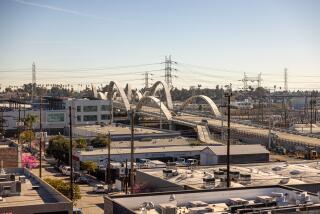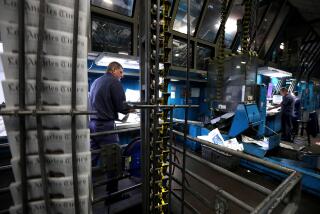End of an Era : Closure of Building 15 Shuts Book on Hughes Aircraft Complex
- Share via
Closing a celebrated chapter in Southern California aerospace history, the aircraft plant in Culver City where Howard Hughes built the Spruce Goose five decades ago is scheduled to shut down this afternoon.
McDonnell Douglas has built helicopter parts in the plant’s cavernous centerpiece, Building 15, since buying Hughes Aircraft Co.’s helicopter line in 1984. But McDonnell has been shifting that work in recent years to its main helicopter site in Mesa, Ariz., and its roughly 50 production workers still in Culver City are calling its quits when the final shift ends at 2 p.m.
“It’s very sad for me, although all of us had known it was coming,” said Betty Percival, who spent 21 years at the plant in administrative posts. “I almost wish I hadn’t seen this part. On the other hand, I wouldn’t have left earlier.”
Hughes began construction on the plant in 1941, and Building 15 was completed in 1943 to accommodate the making of the Spruce Goose, an enormous wooden craft that was also known as the HK-1 Hercules Flying Boat and remains the biggest airplane ever built. More than two dozen other structures were eventually added to the 260-acre site.
Some of the buildings--including one that served as Howard Hughes’ private apartment--are already empty, and the plant’s 4,500-space parking lot is dotted with weeds. Hughes Aircraft’s original headquarters, once famed for its mahogany-trimmed walls, also sits vacant and rotting 18 years after the billionaire’s death.
McDonnell’s main administrative building on the plant is like a ghost town, its dozens of drab offices empty of people and telephones. Hundreds of typewriters, personal computers, desk lamps and chairs that once filled those rooms were auctioned off earlier this week.
The factory floor in Building 15 is filled with idle metal stamping machines, drills, hydraulic presses and welding bays. Some are being put in crates for shipment to Arizona. Overhead, an enormous American flag still hangs from the building’s rafters.
The plant, which once employed as many as 3,000 people, won’t be entirely vacated until the end of the year.
Hughes Aircraft still inhabits two buildings at the site, where 700 workers make high-tech display screens for police cars and other electronic gear. But both McDonnell and Hughes are tenants on the property, with leases expiring at the end of 1994, and Hughes said its employees will leave by then as well.
The property, located in a three-mile corridor at the base of the Westchester Bluffs, is part of the massive Playa Vista project being developed by Maguire Thomas Partners. The company plans to transform the site into a community with housing, offices, stores and hotels.
*
What happens to the plant now?
Nelson Rising, a senior partner at Maguire, said the first phase calls for leaving the buildings there--probably for at least five years--and possibly leasing them to new tenants. He noted that a couple of the structures are already being used by the entertainment industry.
Eventually, “the overall master plan calls for those (buildings) to be replaced as the market dictates,” he said.
But R.D. (Rod) Ayers, a plant manager who arrived at the site in 1969, said it would be a shame to tear down Building 15.
It “is a historical site,” Ayers said. “The biggest aircraft in the whole world was built right in that building over there.”
The plant’s demise ends a unique era: Everything about it reinforced Howard Hughes’ legend as a bigger-than-life innovator.
Building 15, as long as 2 1/2 football fields, with a ceiling eight stories high, was thought to be the world’s largest wooden structure when it was finished, according to Hal Klopper, a McDonnell public relations official and the plant’s unofficial historian.
For decades, the hangar, and most of the other structures, were painted what became known as “Hughes green.” Old-timers still debate whether Hughes used the color because he liked it or because it was postwar surplus and cheap. Building 15 was later covered with aluminum siding to protect the wood, and McDonnell painted the structure powder blue.
The Spruce Goose--a label Hughes despised because the plane was actually made mostly of birch--was 218 feet long and 79 feet high. With Hughes at the controls, the aircraft made its first and only flight over Los Angeles Harbor in late 1947. The plane later was on display in Long Beach, until it was moved to Oregon last year.
The plant also included the world’s longest privately owned runway--nearly two miles--where Hughes again piloted an experimental plane one day in July, 1946, before he crashed in Beverly Hills and was nearly killed. The runway was closed in 1986 and its pavement has been removed.
Over the years, legions of Hughes workers built more than 6,000 military and commercial helicopters, aircraft parts and weapons in Culver City, particularly during the Korean and Vietnam wars. At times they even manufactured wooden rowboats and pinball machines.
One corner of the plant also served as the backdrop to the 1984 movie “Swing Shift,” which centered around a World War II aircraft plant.
And as the years rolled by, stories of the eccentric Howard Hughes--true or not--continued to be handed down.
Ayers, though he never met him, recalled how Hughes ordered his staff to place two pairs of new white socks in a specific desk drawer, because Hughes often arrived wearing sneakers but no socks. The socks were never used, but they remained in the desk until Hughes died, Ayers said.
Decades later, the plant Hughes built is a casualty of the cutbacks in U.S. defense spending, and for the workers “there’s certainly sadness, because you remember all of the good times,” Ayers said. “But those are gone. It’s part of business. Nothing can go on forever.”
More to Read
Inside the business of entertainment
The Wide Shot brings you news, analysis and insights on everything from streaming wars to production — and what it all means for the future.
You may occasionally receive promotional content from the Los Angeles Times.











